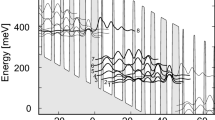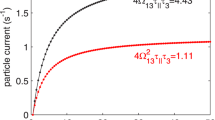Abstract
We derive a Markovian master equation for the single-electron density matrix, applicable to quantum cascade lasers (QCLs). The equation conserves the positivity of the density matrix, includes off-diagonal elements (coherences) as well as in-plane dynamics, and accounts for electron scattering with phonons and impurities. We use the model to simulate a terahertz-frequency QCL, and compare the results with both experiment and simulation via nonequilibrium Green’s functions (NEGF). We obtain very good agreement with both experiment and NEGF when the QCL is biased for optimal lasing. For the considered device, we show that the magnitude of coherences can be a significant fraction of the diagonal matrix elements, which demonstrates their importance when describing THz QCLs. We show that the in-plane energy distribution can deviate far from a heated Maxwellian distribution, which suggests that the assumption of thermalized subbands in simplified density-matrix models is inadequate. We also show that the current density and subband occupations relax toward their steady-state values on very different time scales.








Similar content being viewed by others
References
Faist, J., et al.: Quantum cascade laser. Science 264, 553 (1994)
Dupont, E., Fathololoumi, S., Liu, H.: Simplified density-matrix model applied to three-well terahertz quantum cascade lasers. Phys. Rev. B 81, 205311 (2010)
Jirauschek, C., Kubis, T.: Modeling techniques for quantum cascade lasers. Appl. Phys. Rev. 1, 1, 011307 (2014)
Iotti, R., Rossi, F.: Nature of charge transport in quantum-cascade lasers. Phys. Rev. Lett. 87, 146603 (2001)
Callebaut, H., et al.: Importance of electron-impurity scattering for electron transport in terahertz quantum-cascade lasers. Appl. Phys. Lett. 84, 5, 645 (2004)
Gao, X., Botez, D., Knezevic, I.: X-valley leakage in gaas-based midinfrared quantum cascade lasers: a monte carlo study. J. Appl. Phys. 101, 6, 063101 (2007)
Shi, Y.B., Knezevic, I.: Nonequilibrium phonon effects in midinfrared quantum cascade lasers. J. Appl. Phys. 116, 12, 123105 (2014)
Willenberg, H., Döhler, G.H., Faist, J.: Intersubband gain in a bloch oscillator and quantum cascade laser. Phys. Rev. B 67, 085315 (2003)
Kumar, S., Hu, Q.: Coherence of resonant-tunneling transport in terahertz quantum-cascade lasers. Phys. Rev. B 80, 245316 (2009)
Weber, C., Wacker, A., Knorr, A.: Density-matrix theory of the optical dynamics and transport in quantum cascade structures: the role of coherence. Phys. Rev. B 79, 165322 (2009)
Terazzi, R., Faist, J.: A density matrix model of transport and radiation in quantum cascade lasers. N. J. Phys. 12, 3, 033045 (2010)
Lee, S.-C., Wacker, A.: Nonequilibrium green’s function theory for transport and gain properties of quantum cascade structures. Phys. Rev. B 66, 245314 (2002)
Callebaut, H., Hu, Q.: Importance of coherence for electron transport in terahertz quantum cascade lasers. J. Appl. Phys. 98, 10, 104505 (2005)
Dupont, E., et al.: A phonon scattering assisted injection and extraction based terahertz quantum cascade laser. J. Appl. Phys. 111, 7, 073111 (2012)
Lindskog, M., et al.: Comparative analysis of quantum cascade laser modeling based on density matrices and non-equilibrium green’s functions. Appl. Phys. Lett. 105, 10, 103106 (2014)
Harrison, P., Indjin, D.: Electron temperature and mechanisms of hot carrier generation in quantum cascade lasers. J. Appl. Phys. 92, 11, 6921 (2002)
Frohlich, H.: Theory of electrical breakdown in ionic crystals. Proc. R. Soc. Lond. A 160, 220 (1937)
Breuer, H.P., Petruccione, F.: The Theory of Open Quantum Systems. Oxford University Press, Oxford (2002)
Knezevic, I., Novakovic, B.: Time-dependent transport in open systems based on quantum master equations. J. Comput. Electron. 12, 3, 363 (2013)
Kohn, W., Luttinger, J.M.: Quantum theory of electrical transport phenomena. Phys. Rev. 108, 590 (1957)
Fischetti, M.V.: Master-equation approach to the study of electronic transport in small semiconductor devices. Phys. Rev. B 59, 4901 (1999)
Karimi, F., Davoody, A.H., Knezevic, I.: Dielectric function and plasmons in graphene: a self-consistent-field calculation within a Markovian master equation formalism. Phys. Rev. B 93, 205421 (2016)
Mutze, U.: An asynchronous leapfrog method ii (2013) (Unpublished). arXiv:1311.6602
Wacker, A.: Semiconductor superlattices: a model system for nonlinear transport. Phys. Rep. 357, 1, 1 (2002). (ISSN 0370-1573)
Moiseyev, N.: Quantum theory of resonances: calculating energies, widths and cross-sections by complex scaling. Phys. Rep. 302, 5-6, 212 (1998). (ISSN 0370-1573)
Ferry, D.K.: Semiconductors. IOP Publishing, Bristol (2013). (ISBN 978-0-750-31044-4)
Jacoboni, C., Lugli, P.: The Monte Carlo Method for Semiconductor Device Simulation. Springer, Vienna (1989)
Iotti, R., Ciancio, E., Rossi, F.: Quantum transport theory for semiconductor nanostructures: a density-matrix formulation. Phys. Rev. B 72, 125347 (2005)
Acknowledgments
The authors gratefully acknowledge the support provided by the U.S. Department of Energy, Basic Energy Sciences, Division of Materials Sciences and Engineering, Physical Behavior of Materials Program, Award No. DE-SC0008712. The work was performed using the resources of the UW-Madison Center for High Throughput Computing (CHTC).
Author information
Authors and Affiliations
Corresponding author
Appendix: Calculation of \({\mathcal {G}}\) terms
Appendix: Calculation of \({\mathcal {G}}\) terms
This appendix is devoted to explicit calculation of \({\mathcal {G}}\). This task involves the evaluation of Eq. (21) for different scattering mechanisms, which is repeated here for convenience:
The matrix element \(\mathcal W_g^\mathrm{em}(\mathbf Q,E_k)\) can always be written in terms of \(E_q=\hbar ^2q^2/2m^*, E_k=\hbar ^2k^2/2m^*, E_z=\hbar ^2Q_z^2/2m^*, \) and the angle \(\theta \) between \(\mathbf k\) and \(\mathbf q\). Note that this definition of \(E_z\) is only to make expressions more compact and readable, and the actual energy in the z-direction is contained in the \(\varDelta _{nm}\) terms. Derivations of the various phonon matrix elements \(\mathcal W_g^\mathrm{em}(\mathbf Q)\) used in this section can be found in Refs. [26, 27].
For the case of longitudinal acoustic (LA) phonons, we employ the equipartition approximation and get
where \(D_\mathrm{ac}\) is the deformation potential for acoustic phonons, and \(v_s\) is the sound velocity in the material. In this case, the \(\theta \) integration in Eq. (44) gives \(\mathcal G_\mathrm{LA}^\mathrm{em}=\beta _\mathrm{LA}\). Since acoustic phonons are treated elastically, the emission and absorption terms are identical.
As with the acoustic phonons, the nonpolar optical phonon scattering is isotropic, so the phonon matrix element is constant \(\mathcal W_\mathrm{op}^\mathrm{em}(\mathbf Q)=(N_\mathrm{op}+1)\beta _\mathrm{op}\). The angular integration in Eq. (44) gives \(\mathcal G_\mathrm{op}^\mathrm{em}=(N_\mathrm{op}+1)\beta _\mathrm{op}\).
The phonon matrix element for electron scattering with polar optical phonons, with screening included, is given by
where \(Q_\mathrm{D}\) is the Debye wave vector defined by \(Q_\mathrm{D}^2=ne^2/(\varepsilon k_B T)\) and
where \(\varepsilon _r^\infty \) and \(\varepsilon _r\) are the high-frequency and low-frequency relative permittivities of the material, respectively, and n is the average electron density. The effects of screening are quite small at the electron densities considered in this work; however, the \(1/Q^2\) singularity poses problems in numerical calculations due to the high strength of the POP interaction. These problems are avoided by including screening. We can now calculate
where \(E_\mathrm{D}=\hbar ^2Q_\mathrm{D}^2/2m^*\) is the Debye energy.
The matrix element for ionized impurities is given by
with
where \(N_I\) is the impurity density, and Z is the number of unit charges per impurity. This matrix element gives
Since ionized-impurity scattering is elastic, the absorption term is identical to the emission term.
Rights and permissions
About this article
Cite this article
Jonasson, O., Karimi, F. & Knezevic, I. Partially coherent electron transport in terahertz quantum cascade lasers based on a Markovian master equation for the density matrix. J Comput Electron 15, 1192–1205 (2016). https://doi.org/10.1007/s10825-016-0869-3
Published:
Issue Date:
DOI: https://doi.org/10.1007/s10825-016-0869-3




